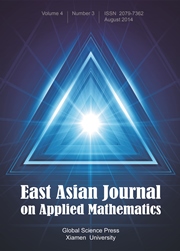Article contents
A Convex and Exact Approach to Discrete Constrained TV-L1 Image Approximation
Published online by Cambridge University Press: 28 May 2015
Abstract
We study the TV-L1 image approximation model from primal and dual perspective, based on a proposed equivalent convex formulations. More specifically, we apply a convex TV-L1 based approach to globally solve the discrete constrained optimization problem of image approximation, where the unknown image function u(x) ∈ {f1,…,fn}, ∀x ∈ Ω. We show that the TV-L1 formulation does provide an exact convex relaxation model to the non-convex optimization problem considered. This result greatly extends recent studies of Chan et al., from the simplest binary constrained case to the general gray-value constrained case, through the proposed rounding scheme. In addition, we construct a fast multiplier-based algorithm based on the proposed primal-dual model, which properly avoids variability of the concerning TV-L1 energy function. Numerical experiments validate the theoretical results and show that the proposed algorithm is reliable and effective.
- Type
- Research Article
- Information
- Copyright
- Copyright © Global-Science Press 2011
References
- 9
- Cited by


